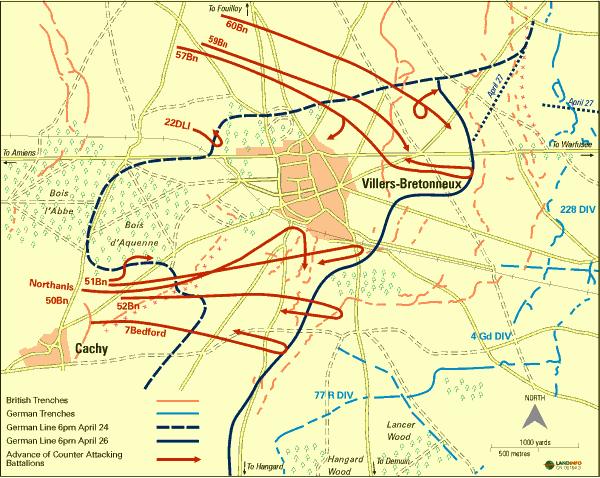1918 - Dernancourt and Villers-Bretonneux: Halting the Germans
- 1918: Australians in France
- Battles
- Dernancourt and Villers-Bretonneux
After the March offensive was launched, German forces continued to push on to Villers-Bretonneux. Instructed to halt this advance, and to replace the badly divided and depleted British forces, Australian troops were commanded to take position and to protect the vital areas of Dernancourt and Villers-Bretonneux from German capture.
Dernancourt
On 4 April, the Germans struck with 15 divisions and captured Hamel, which gave them a footing on the strategically vital "Hill 104", close to the eastern outskirts of Villers-Bretonneux. They then attempted to capture Villers-Bretonneux, which was defended by both British and Australian troops, especially the 4th Division in the Dernancourt sector. They endeavoured to push on to the city of Amiens through an area north of the Somme, but were held back by the Australian brigades. German attempts to break through the lines of protection continued until the night of the 5th, but they never succeeded in penetrating the defences. However, it was to be another three months before Australian troops would recapture Hamel.
By 9 April, the situation was becoming critical as German troops continued to advance closer to the channel ports linking France and Britain, which were now vulnerable to direct attack. Only two Portuguese divisions were holding Lys River fronts (and they eventually fled), and General Ludendorff hastened to exploit this weakness. Some British troops managed to head off the advance, but the Germans pressed on through Armentires to Hazebrouck.
Villers-Bretonneux

Map of the Villers-Bretonneux operation, from Wartime, No. 2, April 1998- the official magazine of the Australian War Memorial.
By 18 April, it was clear that the Germans would attempt to push on to Amiens again. On 24 April, the Germans captured Villers-Bretonneux- which just a few weeks earlier the Australians had fought so hard to defend. The town's defence had been given over to British troops while the Australian divisions regrouped. The enemy attack was spearheaded by tanks, which pushed through the British defences. This battle was unique in that it was the first involving tank-against-tank fighting, demonstrating the significance that tanks had increasingly come to assume in 1918.
Orders for the immediate recapture of Villers-Bretonneux were met with a plan to launch an attack by two brigades, the 13th and the 15th. The unconventional night attack began on the 24th. One brigade approached from the north and one from the south, meeting at the village's eastern edge, thereby surrounding the Germans and driving them from Villers-Bretonneux and the adjacent woods.
Although it is clear that Australian troops played a very important role in halting the German offensive at Villers-Bretonneux, some claim it has been exaggerated. By the time the Australians arrived, British troops had borne the brunt of the German offensive attack, and the Germans were exhausted. Regardless, it is at Villers-Bretonneux that France and Australia hold the main annual commemoration of Anzac Day.
Feature Story: Prisoners of War
French children attending graves of Australians killed in battle on the Western Front, Adelaide cemetery, Villers-Bretonneux.
Australian soldiers with French civilians returning to their homes in Villers-Bretonneux.
The 27th battalion passing through Beaucourt on 7th April 1918, when the 2 Australian division, hurried south from Flanders, moved into the Dernancourt and Villers-Bretonneux sectors to assist and relieve the troops in line.
This memorial cross was erected on the battlefield at Villers-Bretonneux in memory of all the Australians who died there in the counter-attack. This memorial now resides on display at the Australian War Memorial.

A cartoon depicting the AIF's part in Halting the German offensive




